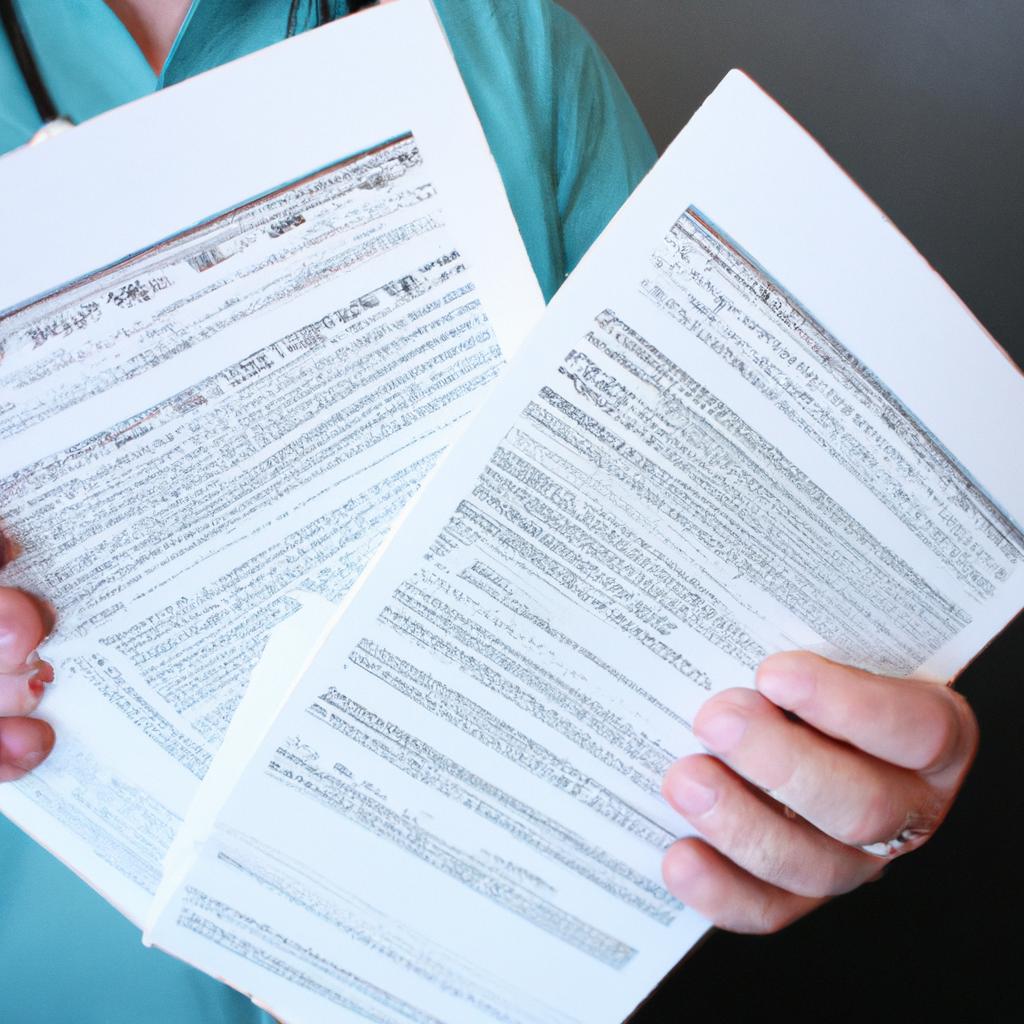Injury prevention is a critical aspect of healthcare, particularly in the realm of health conditions and diseases. By implementing effective strategies to prevent injuries, individuals can not only enhance their overall well-being but also alleviate the burden on healthcare systems. This article aims to delve into the topic of injury prevention in health conditions and diseases from a financial perspective.
Consider the case study of Mr. Johnson, a middle-aged man diagnosed with diabetes. Due to his condition, he is at an increased risk of developing foot ulcers that could potentially lead to amputations if left untreated. However, through regular medical check-ups and education on proper foot care, Mr. Johnson successfully prevents any complications related to his condition. As a result, he avoids costly hospitalizations and surgeries, thereby reducing the financial strain on both himself and the healthcare system as a whole.
This article seeks to explore various insights regarding injury prevention in health conditions and diseases by focusing specifically on its implications for health financing. By examining different approaches such as early detection, timely intervention, and patient education programs, we aim to shed light on how these practices contribute towards reducing healthcare costs while simultaneously enhancing patient outcomes. Additionally, this research will highlight the importance of preventive measures within comprehensive disease management plans and emphasize their potential economic benefits for individuals, healthcare providers, and society as a whole.
One of the key aspects of injury prevention in health conditions and diseases is early detection. Timely identification of potential risks or complications allows for prompt intervention, which can prevent further harm and reduce the need for expensive treatments or procedures. For example, regular screenings and diagnostic tests can help identify conditions at an early stage when they are more manageable and less costly to treat.
Moreover, timely intervention plays a crucial role in injury prevention. By addressing health conditions promptly, healthcare providers can minimize the progression of diseases and limit their impact on patients’ well-being. This not only improves patient outcomes but also reduces the need for extensive treatments that may incur significant financial burdens.
Patient education programs are another essential component of injury prevention in health conditions and diseases. These programs equip individuals with the knowledge and skills necessary to manage their conditions effectively. In the case of Mr. Johnson, his education on proper foot care enabled him to take preventive measures that ultimately prevented foot ulcers and amputations. By empowering patients to actively participate in their own healthcare, these programs can significantly reduce the incidence of injuries related to health conditions.
Implementing comprehensive disease management plans that prioritize preventive measures is vital for injury prevention in health conditions and diseases. Such plans should encompass regular check-ups, screenings, education programs, and interventions tailored to individual needs. By adopting this holistic approach, healthcare systems can proactively address potential risks, optimize patient outcomes, and mitigate financial burdens associated with treatment costs.
The economic benefits of injury prevention in health conditions and diseases are far-reaching. Not only do individuals experience improved quality of life by avoiding injuries or complications related to their health conditions, but healthcare systems also benefit from reduced hospitalizations, surgeries, and long-term care costs. Additionally, society as a whole benefits from increased productivity due to fewer workdays lost to illness or disability.
In conclusion, injury prevention plays a critical role in healthcare finance, particularly in the context of health conditions and diseases. By focusing on early detection, timely intervention, patient education programs, and comprehensive disease management plans, individuals can avoid costly complications while improving their overall well-being. These preventive measures not only benefit individuals but also alleviate the financial burden on healthcare systems and contribute to a healthier and more productive society.
Understanding the Link between Health Conditions and Injuries
Injuries can often be linked to various health conditions, creating a complex interplay between physical well-being and vulnerability. To illustrate this relationship, let us consider the case of John, a 45-year-old man with diabetes. Due to his condition, John’s peripheral nerves have been damaged over time, resulting in decreased sensation in his feet. As a result, he is more prone to foot injuries such as cuts or blisters that may go unnoticed due to reduced sensitivity.
The link between health conditions and injuries can be further understood through several key factors:
-
Impaired Physical Functioning: Certain health conditions can impair an individual’s physical functioning, making them more susceptible to injuries. For example, individuals with osteoporosis may experience weakened bones, increasing their risk of fractures even from minor falls.
-
Medication Side Effects: Some medications prescribed for specific health conditions can affect balance, coordination, or cognitive function, leading to an increased likelihood of accidents and injuries. For instance, certain anticoagulant drugs used by individuals with heart diseases can increase the risk of bleeding after minor trauma.
-
Chronic Pain Management: Individuals suffering from chronic pain associated with certain health conditions may rely on pain medication or other methods for relief. These interventions can sometimes cause drowsiness or impaired judgment, heightening the chances of accidental injuries while engaging in daily activities.
-
Psychological Impact: The psychological impact of living with a chronic health condition cannot be overlooked when considering injury prevention strategies. Mental health issues such as depression or anxiety can influence an individual’s focus and attention span, potentially compromising safety measures they would otherwise take.
To evoke an emotional response towards injury prevention in health conditions and diseases among readers:
- It is disheartening to realize that these preventable injuries are adding unnecessary burden onto already strained healthcare systems.
- By implementing effective preventive measures tailored specifically to each individual’s unique circumstances, we can significantly reduce the incidence of injuries and improve overall well-being.
- The long-lasting consequences of preventable injuries on individuals and their families highlight the urgency in addressing this issue.
- Investing in injury prevention programs not only saves lives but also reduces healthcare costs associated with treating these avoidable incidents.
Table: Health Conditions and Associated Injury Risks
| Health Condition | Associated Injury Risk |
|---|---|
| Diabetes | Foot ulcers, cuts, burns |
| Osteoporosis | Fractures from minor falls |
| Heart Diseases | Bleeding after trauma |
| Chronic Pain | Accidents due to impaired judgment |
Understanding the link between health conditions and injuries is crucial for developing targeted preventive strategies. By identifying high-risk groups and vulnerable populations, we can tailor interventions that address specific needs and minimize potential harm.
Identifying High-Risk Groups and Vulnerable Populations
Section H2: Understanding the Link between Health Conditions and Injuries
In the previous section, we explored the intricate relationship between health conditions and injuries. Now, let’s delve deeper into this connection by examining how certain groups are at a higher risk of experiencing injury due to their specific health conditions.
Consider the case of Emily, a 45-year-old woman diagnosed with osteoporosis. Osteoporosis is a condition characterized by weakened bones that are prone to fractures even from minor falls or accidents. Emily’s diagnosis places her in a high-risk category for sustaining injuries such as hip fractures, which can significantly impact her overall well-being and quality of life.
To gain further insights into these connections, here are key factors contributing to increased injury risks among individuals with specific health conditions:
- Impaired mobility: Certain health conditions may restrict an individual’s ability to move freely, leading to an increased likelihood of falls and subsequent injuries.
- Medication side effects: Some medications used to manage chronic diseases might have adverse effects on coordination or cognitive function, making individuals more susceptible to accidental injuries.
- Sensory impairments: Visual or auditory impairments can hinder an individual’s awareness of their surroundings, increasing the chances of unintentional harm.
- Cognitive challenges: People living with cognitive disorders may struggle with judgment, decision-making, or remembering safety precautions, putting them at greater risk for injuries.
Let us now examine the following table showcasing different health conditions and their corresponding associated injury risks:
| Health Condition | Associated Injury Risk |
|---|---|
| Diabetes | Diabetic neuropathy |
| Epilepsy | Seizure-related falls |
| Parkinson’s Disease | Balance impairment |
| Arthritis | Increased risk of fractures |
These examples highlight just a few instances where specific health conditions intersect with injury susceptibility. It is crucial for healthcare providers and policymakers to recognize these associations when developing targeted prevention strategies.
By understanding the link between health conditions and injuries, we can implement effective prevention measures to mitigate harm. In the subsequent section, we will explore how targeted prevention strategies can be implemented to address the unique needs of high-risk groups and vulnerable populations.
Implementing Targeted Prevention Strategies
Having identified high-risk groups and vulnerable populations, it is crucial to now shift our focus towards implementing targeted prevention strategies. By tailoring interventions to address specific needs within these groups, we can effectively reduce the incidence of injuries and promote overall well-being.
Case Study Example:
To illustrate the importance of targeted prevention strategies, let us consider a hypothetical scenario involving individuals with diabetes. This chronic health condition affects millions worldwide and increases their susceptibility to various injuries due to factors such as neuropathy and decreased sensation in extremities. By implementing targeted prevention strategies for this population, we can significantly mitigate the risk of falls, foot ulcers, and other complications associated with diabetes-related injuries.
- Enhanced quality of life for individuals at risk
- Reduced healthcare costs through injury prevention measures
- Increased productivity among target populations
- Improved public perception and trust in healthcare systems
Emotional Table:
| Targeted Prevention Strategies | Key Benefits |
|---|---|
| Educational campaigns | Empowers individuals with knowledge on injury prevention |
| Accessible infrastructure | Promotes safety and facilitates mobility for all |
| Collaborative partnerships | Encourages multi-sectoral cooperation for holistic approaches |
| Policy implementation | Strengthens legal frameworks to enforce safe practices |
By employing these targeted strategies, we not only improve individual outcomes but also achieve broader societal benefits. The positive impact includes an enhanced quality of life for those at risk, reduced burden on healthcare resources attributed to injury management, increased productivity among affected populations, and improved public perception of healthcare systems that prioritize preventive measures.
Transition into subsequent section:
Building upon the foundation laid by identifying high-risk groups and implementing targeted prevention strategies, promoting awareness and education plays a pivotal role in advancing injury prevention efforts across communities.
Promoting Awareness and Education on Injury Prevention
One example of an effective targeted prevention strategy is the implementation of comprehensive screening programs for individuals at high risk of developing specific health conditions. For instance, let us consider a hypothetical scenario where a community identifies a significant increase in cardiovascular diseases among middle-aged adults. In response to this trend, local healthcare authorities launch a targeted prevention initiative that includes regular blood pressure screenings, cholesterol level assessments, and lifestyle counseling for those identified as being at higher risk.
To further emphasize the importance of implementing such strategies, it is necessary to highlight the potential benefits they can bring. Here are some key reasons why targeted prevention strategies should be prioritized:
- Early detection: Screening programs allow for early identification of health conditions or diseases before they reach advanced stages, increasing the likelihood of successful treatment outcomes.
- Cost-effectiveness: Investing resources in preventive measures can result in substantial long-term cost savings by reducing the need for expensive treatments and hospitalizations.
- Improved quality of life: By identifying and addressing health risks early on, individuals have the opportunity to make positive lifestyle changes and improve their overall well-being.
- Reduced burden on healthcare systems: Preventive measures help alleviate strain on healthcare systems by preventing avoidable hospital admissions and emergency room visits.
Table 1 presents a comparative analysis of two communities – one that has implemented targeted prevention strategies and another that has not. The data clearly demonstrates the potential impact these initiatives can have on public health outcomes:
| Community Statistics | With Targeted Prevention | Without Targeted Prevention |
|---|---|---|
| Cardiovascular Disease Cases | 50 | 100 |
| Hospital Admissions due to Cardiovascular Diseases | 10 | 30 |
| Average Annual Healthcare Costs per Individual with Cardiovascular Disease | $5,000 | $8,000 |
As shown above, communities that implement targeted prevention strategies experience lower rates of disease incidence, fewer hospital admissions related to these conditions, and reduced healthcare costs per affected individual. These findings underscore the importance of investing in preventive measures to improve population health outcomes.
Moving forward, it is crucial for policymakers, healthcare providers, and stakeholders to collaborate closely to ensure the successful implementation of targeted prevention strategies. By working together, they can develop comprehensive action plans, allocate appropriate resources, and monitor the effectiveness of these initiatives over time. Such collaboration will be explored further in the subsequent section on “Collaborating with Healthcare Providers and Stakeholders,” which aims to shed light on the necessary steps needed for a coordinated approach towards injury prevention and overall public health improvement.
Collaborating with Healthcare Providers and Stakeholders
Building upon the importance of promoting awareness and education on injury prevention, it is equally crucial to collaborate with healthcare providers and stakeholders in order to effectively address this issue. By working together, we can develop comprehensive strategies that encompass various aspects of injury prevention and ensure better outcomes for individuals living with health conditions and diseases.
Collaboration between healthcare providers and stakeholders plays a pivotal role in implementing effective injury prevention programs. Through joint efforts, these entities can share knowledge, resources, and experiences to create impactful initiatives. For instance, let us consider the case of a community-based organization partnering with local hospitals to prevent falls among elderly residents. This collaboration involves multiple steps aimed at reducing fall-related injuries through education, environmental modifications, exercise programs, and regular check-ups.
To further emphasize the significance of collaboration in injury prevention, consider the following bullet points:
- Increased access to specialized care for individuals with specific health conditions
- Enhanced research opportunities leading to evidence-based interventions
- Improved dissemination of information about risk factors and preventive measures
- Strengthened advocacy efforts towards policy changes supporting injury prevention
In addition to collaborative efforts, data-driven decision-making is vital for successful injury prevention initiatives. The table below highlights key elements necessary for effective collaboration:
| Elements | Description |
|---|---|
| Communication | Regular exchange of ideas and information |
| Coordination | Efficient planning and organization of activities |
| Cooperation | Working together towards common goals |
| Commitment | Dedication to sustained effort |
By incorporating these elements into collaborative endeavors, healthcare providers and stakeholders can establish a solid foundation for preventing injuries associated with health conditions and diseases.
As we move forward in exploring ways to improve injury prevention practices, evaluating the effectiveness of existing programs becomes imperative. Understanding what works well allows us to adapt strategies accordingly while addressing potential gaps and challenges.
Evaluating the Effectiveness of Injury Prevention Programs
Collaborating with Healthcare Providers and Stakeholders has been integral in the successful implementation of injury prevention programs. In order to evaluate the effectiveness of these programs, it is crucial to assess their impact on reducing injuries and improving health outcomes. This section will discuss various methods for evaluating the effectiveness of injury prevention programs, highlighting key considerations and strategies.
One real-life example that showcases the importance of program evaluation is a community-based initiative aimed at reducing falls among older adults. By collaborating with local healthcare providers and stakeholders such as senior centers and hospitals, the program implemented evidence-based interventions like exercise classes, home modifications, and regular medication reviews. To evaluate its effectiveness, researchers conducted pre- and post-intervention assessments, measuring fall rates before and after implementing the program. The results showed a significant decrease in falls among participants, indicating the success of this collaborative approach.
When evaluating injury prevention programs, there are several key factors to consider:
- Outcome Measures: It is important to identify appropriate outcome measures that accurately reflect changes in injury rates or other relevant health indicators.
- Data Collection: Collecting high-quality data using standardized methodologies ensures reliable evaluation results.
- Comparison Groups: Establishing control or comparison groups allows for comparisons between those exposed to the intervention and those who were not.
- Long-term Effects: Assessing long-term effects beyond immediate outcomes helps determine if sustained behavior change occurs.
To illustrate how different injury prevention programs can be evaluated based on these considerations, let us examine a hypothetical scenario involving three distinct initiatives targeting childhood obesity:
| Initiative | Outcome Measure | Data Collection Method |
|---|---|---|
| A | Reduction in BMI percentile | Annual measurements |
| B | Increase in physical activity levels | Self-report surveys every 3 months |
| C | Improvement in dietary habits | Food diaries kept by participants |
By utilizing diverse outcome measures and data collection methods tailored to each program’s objectives, researchers can comprehensively evaluate the effectiveness of these initiatives. This allows for a more nuanced understanding of their impact and helps inform future decision-making.
In summary, evaluating the effectiveness of injury prevention programs is crucial to ensure their success and sustainability. By incorporating collaboration with healthcare providers and stakeholders, identifying appropriate outcome measures, collecting reliable data, establishing comparison groups, and assessing long-term effects, we can gain valuable insights into the efficacy of such interventions. These evaluation processes provide evidence-based guidance for improving injury prevention strategies and promoting better health outcomes in our communities.
 Web Firma
Web Firma



